St. Augustine of Hippo
The great St. Augustine’s life is unfolded to us in documents of unrivaled richness, and of no great character of ancient times have we information comparable to that contained in the “Confessions,” which relate the touching story of his soul, the “Retractations,” which give the history of his mind, and the “Life of Augustine,” written by his friend Possidius, telling of the saint’s apostolate.
We will confine ourselves to sketching the three periods of this great life: (1) the young wanderer’s gradual return to the Faith; (2) the doctrinal development of the Christian philosopher to the time of his episcopate; and (3) the full development of his activities upon the Episcopal throne of Hippo.
Statue of St. Monica, the Mother of St. Augustine.
I. FROM HIS BIRTH TO HIS CONVERSION (354-386)
Augustine was born at Tagaste on 13 November, 354. Tagaste, now Souk-Ahras, about 60 miles from Bona (ancient Hippo-Regius), was at that time a small free city of proconsular Numidia which had recently been converted from Donatism. Although eminently respectable, his family was not rich, and his father, Patricius, one of the curiales of the city, was still a pagan. However, the admirable virtues that made Monica the ideal of Christian mothers at length brought her husband the grace of baptism and of a holy death, about the year 371.
Augustine received a Christian education. His mother had him signed with the cross and enrolled among the catechumens. Once, when very ill, he asked for baptism, but, all danger being soon passed, he deferred receiving the sacrament, thus yielding to a deplorable custom of the times. His association with “men of prayer” left three great ideas deeply engraven upon his soul: a Divine Providence, the future life with terrible sanctions, and, above all, Christ the Saviour. “From my tenderest infancy, I had in a manner sucked with my mother’s milk that name of my Saviour, Thy Son; I kept it in the recesses of my heart; and all that presented itself to me without that Divine Name, though it might be elegant, well written, and even replete with truth, did not altogether carry me away” (Confessions, I, iv).
But a great intellectual and moral crisis stifled for a time all these Christian sentiments. The heart was the first point of attack. Patricius, proud of his son’s success in the schools of Tagaste and Madaura determined to send him to Carthage to prepare for a forensic career. But, unfortunately, it required several months to collect the necessary means, and Augustine had to spend his sixteenth year at Tagaste in an idleness which was fatal to his virtue; he gave himself up to pleasure with all the vehemence of an ardent nature. At first he prayed, but without the sincere desire of being heard, and when he reached Carthage, towards the end of the year 370, every circumstance tended to draw him from his true course: the many seductions of the great city that was still half pagan, the licentiousness of other students, the theatres, the intoxication of his literary success, and a proud desire always to be first, even in evil. Before long he was obliged to confess to Monica that he had formed a sinful liaison with the person who bore him a son (372), “the son of his sin” – an entanglement from which he only delivered himself at Milan after fifteen years of its thralldom. Two extremes are to be avoided in the appreciation of this crisis. Some, like Mommsen, misled perhaps by the tone of grief in the “Confessions,” have exaggerated it: in the “Realencyklopädie” (3d ed., II, 268) Loofs reproves Mommsen on this score, and yet he himself is to lenient towards Augustine, when he claims that in those days, the Church permitted concubinage. The “Confessions” alone prove that Loofs did not understand the 17th canon of Toledo. However, it may be said that, even in his fall, Augustine maintained a certain dignity and felt a compunction which does him honour, and that, from the age of nineteen, he had a genuine desire to break the chain. In fact, in 373, an entirely new inclination manifested itself in his life, brought about by the reading Cicero’s “Hortensius” whence he imbibed a love of the wisdom which Cicero so eloquently praises. Thenceforward Augustine looked upon rhetoric merely as a profession; his heart was in philosophy.
Augustine at school
Unfortunately, his faith, as well as his morals, was to pass though a terrible crisis. In this same year, 373, Augustine and his friend Honoratus fell into the snares of the Manichæans. It seems strange that so great a mind should have been victimized by Oriental vapourings, synthesized by the Persian Mani (215-276) into coarse, material dualism, and introduced into Africa scarcely fifty years previously. Augustine himself tells us that he was enticed by the promises of a free philosophy unbridled by faith; by the boasts of the Manichæans, who claimed to have discovered contradictions in Holy Writ; and, above all, by the hope of finding in their doctrine a scientific explanation of nature and its most mysterious phenomena. Augustine’s inquiring mind was enthusiastic for the natural sciences, and the Manichæans declared that nature withheld no secrets from Faustus, their doctor. Moreover, being tortured by the problem of the origin of evil, Augustine, in default of solving it, acknowledged a conflict of two principles. And then, again, there was a very powerful charm in the moral irresponsibility resulting from a doctrine which denied liberty and attributed the commission of crime to a foreign principle.
Once won over to this sect, Augustine devoted himself to it with all the ardour of his character; he read all its books, adopted and defended all its opinions. His furious proselytism drew into error his friend Alypius and Romanianus, his Mæcenas of Tagaste, the friend of his father who was defraying the expenses of Augustine’s studies. It was during this Manichæan period that Augustine’s literary faculties reached their full development, and he was still a student at Carthage when he embraced error. His studies ended, he should in due course have entered the forum litigiosum, but he preferred the career of letters, and Possidius tells us that he returned to Tagaste to “teach grammar.” The young professor captivated his pupils, one of whom, Alypius, hardly younger than his master, loath to leave, him after following him into error, was afterwards baptized with him at Milan, eventually becoming Bishop of Tagaste, his native city. But Monica deeply deplored Augustine’s heresy and would not have received him into her home or at her table but for the advice of a saintly bishop, who declared that “the son of so many tears could not perish.” Soon afterwards Augustine went to Carthage, where he continued to teach rhetoric. His talents shone to even better advantage on this wider stage, and by an indefatigable pursuit of the liberal arts his intellect attained its full maturity. Having taken part in a poetic tournament, he carried off the prize, and the Proconsul Vindicianus publicly conferred upon him the corona agonistica. It was at this moment of literary intoxication, when he had just completed his first work on æsthetics, now lost that he began to repudiate Manichæism. Even when Augustine was in his first fervour, the teachings of Mani had been far from quieting his restlessness, and although he has been accused of becoming a priest of the sect, he was never initiated or numbered among the “elect,” but remained an “auditor” the lowest degree in the hierarchy. He himself gives the reason for his disenchantment. First of all there was the fearful depravity of Manichæan philosophy – “They destroy everything and build up nothing”; then, the dreadful immorality in contrast with their affectation of virtue; the feebleness of their arguments in controversy with the Catholics, to whose Scriptural arguments their only reply was: “The Scriptures have been falsified.” But, worse than all, he did not find science among them – science in the modern sense of the word – that knowledge of nature and its laws which they had promised him. When he questioned them concerning the movements of the stars, none of them could answer him. “Wait for Faustus,” they said, “he will explain everything to you.” Faustus of Mileve, the celebrated Manichæan bishop, at last came to Carthage; Augustine visited and questioned him, and discovered in his responses the vulgar rhetorician, the utter stranger to all scientific culture. The spell was broken, and, although Augustine did not immediately abandon the sect, his mind rejected Manichæan doctrines. The illusion had lasted nine years.
Conversion of St. Augustine. Painting by Benozzo Gozzoli of St. Augustine reading the Epistle of St Paul.
But the religious crisis of this great soul was only to be resolved in Italy, under the influence of Ambrose. In 383 Augustine, at the age of twenty-nine, yielded to the irresistible attraction which Italy had for him, but his mother suspected his departure and was so reluctant to be separated from him that he resorted to a subterfuge and embarked under cover of the night. He had only just arrived in Rome when he was taken seriously ill; upon recovering he opened a school of rhetoric, but, disgusted by the tricks of his pupils, who shamelessly defrauded him of their tuition fees, he applied for a vacant professorship at Milan, obtained it, and was accepted by the prefect, Symmachus. Having visited Bishop Ambrose, the fascination of that saint’s kindness induced him to become a regular attendant at his preachings. However, before embracing the Faith, Augustine underwent a three years’ struggle during which his mind passed through several distinct phases. At first he turned towards the philosophy of the Academics, with its pessimistic scepticism; then neo-Platonic philosophy inspired him with genuine enthusiasm. At Milan he had scarcely read certain works of Plato and, more especially, of Plotinus, before the hope of finding the truth dawned upon him. Once more he began to dream that he and his friends might lead a life dedicated to the search for it, a life purged of all vulgar aspirations after honours, wealth, or pleasure, and with celibacy for its rule (Confessions, VI). But it was only a dream; his passions still enslaved him. Monica, who had joined her son at Milan, prevailed upon him to become betrothed, but his affianced bride was too young, and although Augustine dismissed the mother of Adeodatus, her place was soon filled by another. Thus did he pass through one last period of struggle and anguish. Finally, through the reading of the Holy Scriptures light penetrated his mind. Soon he possessed the certainty that Jesus Christ is the only way to truth and salvation. After that resistance came only from the heart. An interview with Simplicianus, the future successor of St. Ambrose, who told Augustine the story of the conversion of the celebrated neo-Platonic rhetorician, Victorinus (Confessions, VIII, i, ii), prepared the way for the grand stroke of grace which, at the age of thirty-three, smote him to the ground in the garden at Milan (September, 386). A few days later Augustine, being ill, took advantage of the autumn holidays and, resigning his professorship, went with Monica, Adeodatus, and his friends to Cassisiacum, the country estate of Verecundus, there to devote himself to the pursuit of true philosophy which, for him, was now inseparable from Christianity.
II. FROM HIS CONVERSION TO HIS EPISCOPATE (386-395)
Baptism of St. Augustine
Augustine gradually became acquainted with Christian doctrine, and in his mind the fusion of Platonic philosophy with revealed dogmas was taking place. The law that governed this change of thought has of late years been frequently misconstrued; it is sufficiently important to be precisely defined. The solitude of Cassisiacum realized a long-cherished dream. In his books “Against the Academics,” Augustine has described the ideal serenity of this existence, enlivened only by the passion for truth. He completed the education of his young friends, now by literary readings in common, now by philosophical conferences to which he sometimes invited Monica, and the accounts of which, compiled by a secretary, have supplied the foundation of the “Dialogues.” Licentius, in his “Letters,” would later on recall these delightful philosophical mornings and evenings, at which Augustine was wont to evolve the most elevating discussions from the most commonplace incidents. The favourite topics at their conferences were truth, certainty (Against the Academics), true happiness in philosophy (On a Happy Life), the Providential order of the world and the problem of evil (On Order) and finally God and the soul (Soliloquies, On the Immortality of the Soul).
Here arises the curious question propounded modern critics: Was Augustine a Christian when wrote these “Dialogues” at Cassisiacum? Until now no one had doubted it; historians, relying upon the “Confessions,” had all believed that Augustine’s retirement to the villa had for its twofold object the improvement of his health and his preparation for baptism. But certain critics nowadays claim to have discovered a radical opposition between the philosophical “Dialogues” composed in this retirement and the state of soul described in the “Confessions.” According to Harnack, in writing the “Confessions” Augustine must have projected upon the recluse of 386 the sentiments of the bishop of 400. Others go farther and maintain that the recluse of the Milanese villa could not have been at heart a Christian, but a Platonist; and that the scene in the garden was a conversion not to Christianity, but to philosophy, the genuinely Christian phase beginning only in 390. But this interpretation of the “Dialogues” cannot withstand the test of facts and texts. It is admitted that Augustine received baptism at Easter, 387; and who could suppose that it was for him a meaningless ceremony? So too, how can it be admitted that the scene in the garden, the example of the recluses, the reading of St. Paul, the conversion of Victorinus, Augustine’s ecstasies in reading the Psalms with Monica were all invented after the fact? Again, as it was in 388 that Augustine wrote his beautiful apology “On the Holiness of the Catholic Church,” how is it conceivable that he was not yet a Christian at that date? To settle the argument, however, it is only necessary to read the “Dialogues” themselves. They are certainly a purely philosophical work – a work of youth, too, not without some pretension, as Augustine ingenuously acknowledges (Confessions, IX, iv); nevertheless, they contain the entire history of his Christian formation. As early as 386, the first work written at Cassisiacum reveals to us the great underlying motive of his researches. The object of his philosophy is to give authority the support of reason, and “for him the great authority, that which dominates all others and from which he never wished to deviate, is the authority of Christ”; and if he loves the Platonists it is because he counts on finding among them interpretations always in harmony with his faith (Against the Academics, III, c. x). To be sure such confidence was excessive, but it remains evident that in these “Dialogues” it is a Christian, and not a Platonist, that speaks. He reveals to us the intimate details of his conversion, the argument that convinced him (the life and conquests of the Apostles), his progress in the Faith at the school of St. Paul (ibid., II, ii), his delightful conferences with his friends on the Divinity of Jesus Christ, the wonderful transformations worked in his soul by faith, even to that victory of his over the intellectual pride which his Platonic studies had aroused in him (On The Happy Life, I, ii), and at last the gradual calming of his passions and the great resolution to choose wisdom for his only spouse (Soliloquies, I, x).
The Consecration of St Augustine, painted by Jaume Huguet
It is now easy to appreciate at its true value the influence of neo-Platonism upon the mind of the great African Doctor. It would be impossible for anyone who has read the works of St. Augustine to deny the existence of this influence. However, it would be a great exaggeration of this influence to pretend that it at any time sacrificed the Gospel to Plato. The same learned critic thus wisely concludes his study: “So long, therefore, as his philosophy agrees with his religious doctrines, St. Augustine is frankly neo-Platonist; as soon as a contradiction arises, he never hesitates to subordinate his philosophy to religion, reason to faith. He was, first of all, a Christian; the philosophical questions that occupied his mind constantly found themselves more and more relegated to the background” (op. cit., 155). But the method was a dangerous one; in thus seeking harmony between the two doctrines he thought too easily to find Christianity in Plato, or Platonism in the Gospel. More than once, in his “Retractations” and elsewhere, he acknowledges that he has not always shunned this danger. Thus he had imagined that in Platonism he discovered the entire doctrine of the Word and the whole prologue of St. John. He likewise disavowed a good number of neo-Platonic theories which had at first misled him – the cosmological thesis of the universal soul, which makes the world one immense animal – the Platonic doubts upon that grave question: Is there a single soul for all or a distinct soul for each? But on the other hand, he had always reproached the Platonists, as Schaff very properly remarks (Saint Augustine, New York, 1886, p. 51), with being ignorant of, or rejecting, the fundamental points of Christianity: “first, the great mystery, the Word made flesh; and then love, resting on the basis of humility.” They also ignore grace, he says, giving sublime precepts of morality without any help towards realizing them.
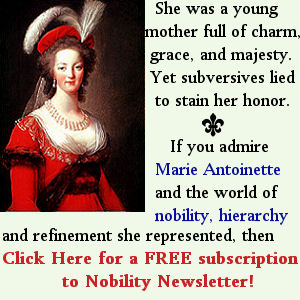 It was this Divine grace that Augustine sought in Christian baptism. Towards the beginning of Lent, 387, he went to Milan and, with Adeodatus and Alypius, took his place among the competentes, being baptized by Ambrose on Easter Day, or at least during Eastertide. The tradition maintaining that the Te Deum was sung on that occasion by the bishop and the neophyte alternately is groundless. Nevertheless this legend is certainly expressive of the joy of the Church upon receiving as her son him who was to be her most illustrious doctor. It was at this time that Augustine, Alypius, and Evodius resolved to retire into solitude in Africa. Augustine undoubtedly remained at Milan until towards autumn, continuing his works: “On the Immortality of the Soul” and “On Music.” In the autumn of 387, he was about to embark at Ostia, when Monica was summoned from this life. In all literature there are no pages of more exquisite sentiment than the story of her saintly death and Augustine’s grief (Confessions, IX). Augustine remained several months in Rome, chiefly engaged in refuting Manichæism. He sailed for Africa after the death of the tyrant Maximus (August 388) and after a short sojourn in Carthage, returned to his native Tagaste. Immediately upon arriving there, he wished to carry out his idea of a perfect life, and began by selling all his goods and giving the proceeds to the poor. Then he and his friends withdrew to his estate, which had already been alienated, there to lead a common life in poverty, prayer, and the study of sacred letters. Book of the “LXXXIII Questions” is the fruit of conferences held in this retirement, in which he also wrote “De Genesi contra Manichæos,” “De Magistro,” and, “De Vera Religione.”
It was this Divine grace that Augustine sought in Christian baptism. Towards the beginning of Lent, 387, he went to Milan and, with Adeodatus and Alypius, took his place among the competentes, being baptized by Ambrose on Easter Day, or at least during Eastertide. The tradition maintaining that the Te Deum was sung on that occasion by the bishop and the neophyte alternately is groundless. Nevertheless this legend is certainly expressive of the joy of the Church upon receiving as her son him who was to be her most illustrious doctor. It was at this time that Augustine, Alypius, and Evodius resolved to retire into solitude in Africa. Augustine undoubtedly remained at Milan until towards autumn, continuing his works: “On the Immortality of the Soul” and “On Music.” In the autumn of 387, he was about to embark at Ostia, when Monica was summoned from this life. In all literature there are no pages of more exquisite sentiment than the story of her saintly death and Augustine’s grief (Confessions, IX). Augustine remained several months in Rome, chiefly engaged in refuting Manichæism. He sailed for Africa after the death of the tyrant Maximus (August 388) and after a short sojourn in Carthage, returned to his native Tagaste. Immediately upon arriving there, he wished to carry out his idea of a perfect life, and began by selling all his goods and giving the proceeds to the poor. Then he and his friends withdrew to his estate, which had already been alienated, there to lead a common life in poverty, prayer, and the study of sacred letters. Book of the “LXXXIII Questions” is the fruit of conferences held in this retirement, in which he also wrote “De Genesi contra Manichæos,” “De Magistro,” and, “De Vera Religione.”
Augustine did not think of entering the priesthood, and, through fear of the episcopacy, he even fled from cities in which an election was necessary. One day, having been summoned to Hippo by a friend whose soul’s salvation was at stake, he was praying in a church when the people suddenly gathered about him, cheered him, and begged Valerius, the bishop, to raise him to the priesthood. In spite of his tears Augustine was obliged to yield to their entreaties, and was ordained in 391. The new priest looked upon his ordination as an additional reason for resuming religious life at Tagaste, and so fully did Valerius approve that he put some church property at Augustine’s disposal, thus enabling him to establish a monastery the second that he had founded. His priestly ministry of five years was admirably fruitful; Valerius had bidden him preach, in spite of the deplorable custom which in Africa reserved that ministry to bishops. Augustine combated heresy, especially Manichæism, and his success was prodigious. Fortunatus, one of their great doctors, whom Augustine had challenged in public conference, was so humiliated by his defeat that he fled from Hippo. Augustine also abolished the abuse of holding banquets in the chapels of the martyrs. He took part, 8 October, 393, in the Plenary Council of Africa, presided over by Aurelius, Bishop of Carthage, and, at the request of the bishops, was obliged to deliver a discourse which, in its completed form, afterwards became the treatise “De Fide et symbolo.”
III. AS BISHOP OF HIPPO (396-430)
Enfeebled by old age, Valerius, Bishop of Hippo, obtained the authorization of Aurelius, 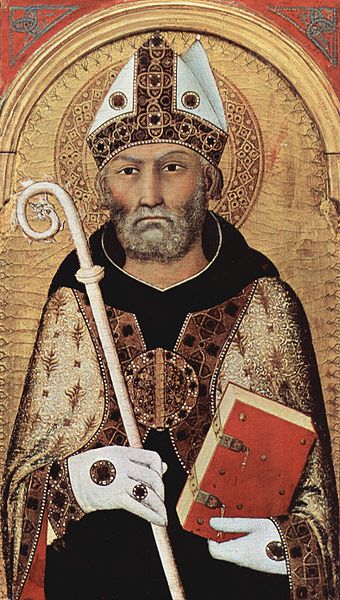 Primate of Africa, to associate Augustine with himself as coadjutor. Augustine had to resign himself to consecration at the hands of Megalius, Primate of Numidia. He was then forty two, and was to occupy the See of Hippo for thirty-four years. The new bishop understood well how to combine the exercise of his pastoral duties with the austerities of the religious life, and although he left his convent, his episcopal residence became a monastery where he lived a community life with his clergy, who bound themselves to observe religious poverty. Was it an order of regular clerics or of monks that he thus founded? This is a question often asked, but we feel that Augustine gave but little thought to such distinctions. Be that as it may, the episcopal house of Hippo became a veritable nursery which supplied the founders of the monasteries that were soon spread all over Africa and the bishops who occupied the neighbouring sees. Possidius (Vita S. August., xxii) enumerates ten of the saint’s friends and disciples who were promoted to the episcopacy. Thus it was that Augustine earned the title of patriarch of the religious, and renovator of the clerical, life in Africa.
Primate of Africa, to associate Augustine with himself as coadjutor. Augustine had to resign himself to consecration at the hands of Megalius, Primate of Numidia. He was then forty two, and was to occupy the See of Hippo for thirty-four years. The new bishop understood well how to combine the exercise of his pastoral duties with the austerities of the religious life, and although he left his convent, his episcopal residence became a monastery where he lived a community life with his clergy, who bound themselves to observe religious poverty. Was it an order of regular clerics or of monks that he thus founded? This is a question often asked, but we feel that Augustine gave but little thought to such distinctions. Be that as it may, the episcopal house of Hippo became a veritable nursery which supplied the founders of the monasteries that were soon spread all over Africa and the bishops who occupied the neighbouring sees. Possidius (Vita S. August., xxii) enumerates ten of the saint’s friends and disciples who were promoted to the episcopacy. Thus it was that Augustine earned the title of patriarch of the religious, and renovator of the clerical, life in Africa.
But he was above all the defender of truth and the shepherd of souls. His doctrinal activities, the influence of which was destined to last as long as the Church itself, were manifold: he preached frequently, sometimes for five days consecutively, his sermons breathing a spirit of charity that won all hearts; he wrote letters which scattered broadcast through the then known world his solutions of the problems of that day; he impressed his spirit upon divers African councils at which he assisted, for instance, those of Carthage in 398, 401, 407, 419 and of Mileve in 416 and 418; and lastly struggled indefatigably against all errors. To relate these struggles were endless; we shall, therefore, select only the chief controversies and indicate in each the doctrinal attitude of the great Bishop of Hippo.
A. The Manichæan Controversy and the Problem of Evil
After Augustine became bishop the zeal which, from the time of his baptism, he had manifested in bringing his former co-religionists into the true Church, took on a more paternal form without losing its pristine ardour – “let those rage against us who know not at what a bitter cost truth is attained. . . . As for me, I should show you the same forbearance that my brethren had for me when I blind, was wandering in your doctrines” (Contra Epistolam Fundamenti, iii).
Among the most memorable events that occurred during this controversy was the great victory won in 404 over Felix, one of the “elect” of the Manichæans and the great doctor of the sect. He was propagating his errors in Hippo, and Augustine invited him to a public conference the issue of which would necessarily cause a great stir; Felix declared himself vanquished, embraced the Faith, and, together with Augustine, subscribed the acts of the conference. In his writings Augustine successively refuted Mani (397), the famous Faustus (400), Secundinus (405), and (about 415) the fatalistic Priscillianists whom Paulus Orosius had denounced to him. These writings contain the saint’s clear, unquestionable views on the eternal problem of evil, views based on an optimism proclaiming, like the Platonists, that every work of God is good and that the only source of moral evil is the liberty of creatures (De Civitate Dei, XIX, c. xiii, n. 2). Augustine takes up the defence of free will, even in man as he is, with such ardour that his works against the Manichæan are an inexhaustible storehouse of arguments in this still living controversy.
Four Doctors of the Church, LtoR: St. Augustine, St. Gregory the Great, St. Jerome, St. Ambrosius
In vain have the Jansenists maintained that Augustine was unconsciously a Pelagian and that he afterwards acknowledged the loss of liberty through the sin of Adam. Modern critics, doubtless unfamiliar with Augustine’s complicated system and his peculiar terminology, have gone much farther. In the “Revue d’histoire et de littérature religieuses” (1899, p. 447), M. Margival exhibits St. Augustine as the victim of metaphysical pessimism unconsciously imbibed from Manichæan doctrines. “Never,” says he, “will the Oriental idea of the necessity and the eternity of evil have a more zealous defender than this bishop.” Nothing is more opposed to the facts. Augustine acknowledges that he had not yet understood how the first good inclination of the will is a gift of God (Retractions, I, xxiii, n, 3); but it should be remembered that he never retracted his leading theories on liberty, never modified his opinion upon what constitutes its essential condition, that is to say, the full power of choosing or of deciding. Who will dare to say that in revising his own writings on so important a point he lacked either clearness of perception or sincerity?
B. The Donatist Controversy and the Theory of the Church
The Donatist schism was the last episode in the Montanist and Novatian controversies which had agitated the Church from the second century. While the East was discussing under varying aspects the Divine and Christological problem of the Word, the West, doubtless because of its more practical genius, took up the moral question of sin in all its forms. The general problem was the holiness of the Church; could the sinner be pardoned, and remain in her bosom? In Africa the question especially concerned the holiness of the hierarchy. The bishops of Numidia, who, in 312, had refused to accept as valid the consecration of Cæcilian, Bishop of Carthage, by a traditor, had inaugurated the schism and at the same time proposed these grave questions: Do the hierarchical powers depend upon the moral worthiness of the priest? How can the holiness of the Church be compatible with the unworthiness of its ministers?
At the time of Augustine’s arrival in Hippo, the schism had attained immense proportions, having become identified with political tendencies – perhaps with a national movement against Roman domination. In any event, it is easy to discover in it an undercurrent of anti-social revenge which the emperors had to combat by strict laws. The strange sect known as “Soldiers of Christ,” and called by Catholics Circumcelliones (brigands, vagrants), resembled the revolutionary sects of the Middle Ages in point of fanatic destructiveness – a fact that must not be lost sight of, if the severe legislation of the emperors is to be properly appreciated.
St. Augustine used to meditate long and hard on the mystery of the Holy Trinity, as he tried to understand it. Strolling along the seashore one day wondering how there could be Three Persons in one God, he noticed a small child repeatedly scooping up water from the sea in a shell and carried it to a hole in the sand into which he emptied the water. Curious, St. Augustine walked over and asked the child what he was doing. Smiling up at him the child said, "I am emptying the sea into this hole." St. Augustine replied, "Why, even if you spent your whole life at this task, child, you could never complete it. The sea is far too vast and deep to be contained in so small a hole!" The child looked up solemnly at St. Augustine and said: "Yet I will complete this task before you can ever fully comprehend the Mystery of the Holy Trinity." and with that, the child vanished. St. Augustine then realized that he was an angel sent to him by God to point out the futility of his efforts to understand this Mystery.
The history of Augustine’s struggles with the Donatists is also that of his change of opinion on the employment of rigorous measures against the heretics; and the Church in Africa, of whose councils he had been the very soul, followed him in the change. This change of views is solemnly attested by the Bishop of Hippo himself, especially in his Letters, xciii (in the year 408). In the beginning, it was by conferences and a friendly controversy that he sought to re-establish unity. He inspired various conciliatory measures of the African councils, and sent ambassadors to the Donatists to invite them to re-enter the Church, or at least to urge them to send deputies to a conference (403). The Donatists met these advances at first with silence, then with insults, and lastly with such violence that Possidius Bishop of Calamet, Augustine’s friend, escaped death only by flight, the Bishop of Bagaïa was left covered with horrible wounds, and the life of the Bishop of Hippo himself was several times attempted (Letter lxxxviii, to Januarius, the Donatist bishop).
This madness of the Circumcelliones required harsh repression, and Augustine, witnessing the many conversions that resulted therefrom, thenceforth approved rigid laws. However, this important restriction must be pointed out: that St. Augustine never wished heresy to be punishable by death – Vos rogamus ne occidatis (Letter c, to the Proconsul Donatus). But the bishops still favoured a conference with the schismatics, and in 410 an edict issued by Honorius put an end to the refusal of the Donatists. A solemn conference took place at Carthage, in June, 411, in presence of 286 Catholic, and 279 Donatist bishops. The Donatist spokesmen were Petilian of Constantine, Primian of Carthage, and Emeritus of Cæsarea; the Catholic orators, Aurelius and Augustine. On the historic question then at issue, the Bishop of Hippo proved the innocence of Cæcilian and his consecrator Felix, and in the dogmatic debate he established the Catholic thesis that the Church, as long as it is upon earth, can, without losing its holiness, tolerate sinners within its pale for the sake of converting them. In the name of the emperor the Proconsul Marcellinus sanctioned the victory of the Catholics on all points. Little by little Donatism died out, to disappear with the coming of the Vandals.
So amply and magnificently did Augustine develop his theory on the Church that, according to Specht “he deserves to be named the Doctor of the Church as well as the Doctor of Grace”; and Möhler (Dogmatik, 351) is not afraid to write: “For depth of feeling and power of conception nothing written on the Church since St. Paul’s time, is comparable to the works of St. Augustine.” He has corrected, perfected, and even excelled the beautiful pages of St. Cyprian on the Divine institution of the Church, its authority, its essential marks, and its mission in the economy of grace and the administration of the sacraments. The Protestant critics, Dorner, Bindemann, Böhringer and especially Reuter, loudly proclaim, and sometimes even exaggerate, this rôle of the Doctor of Hippo; and while Harnack does not quite agree with them in every respect he does not hesitate to say (History of Dogma, II, c. iii): “It is one of the points upon which Augustine specially affirms and strengthens the Catholic idea…. He was the first [!] to transform the authority of the Church into a religious power, and to confer upon practical religion the gift of a doctrine of the Church.” He was not the first, for Dorner acknowledges (Augustinus, 88) that Optatus of Mileve had expressed the basis of the same doctrines. Augustine, however, deepened, systematized, and completed the views of St. Cyprian and Optatus. But it is impossible here to go into detail. (See Specht, Die Lehre von der Kirche nach dem hl. Augustinus, Paderborn, l892.)
C. The Pelagian Controversy and the Doctor of Grace
The Burial of Saint Augustine. ca. 1745.
The close of the struggle against the Donatists almost coincided with the beginnings of a very grave theological dispute which not only was to demand Augustine’s unremitting attention up to the time of his death, but was to become an eternal problem for individuals and for the Church. Farther on we shall enlarge upon Augustine’s system; here we need only indicate the phases of the controversy. Africa, where Pelagius and his disciple Celestius had sought refuge after the taking of Rome by Alaric, was the principal centre of the first Pelagian disturbances; as early as 412 a council held at Carthage condemned Pelagians for their attacks upon the doctrine of original sin. Among other books directed against them by Augustine was his famous “De naturâ et gratiâ.” Thanks to his activity the condemnation of these innovators, who had succeeded in deceiving a synod convened at Diospolis in Palestine, was reiterated by councils held later at Carthage and Mileve and confirmed by Pope Innocent I (417). A second period of Pelagian intrigues developed at Rome, but Pope Zosimus, whom the stratagems of Celestius had for a moment deluded, being enlightened by Augustine, pronounced the solemn condemnation of these heretics in 418. Thenceforth the combat was conducted in writing against Julian of Eclanum, who assumed the leadership of the party and violently attacked Augustine. Towards 426 there entered the lists a school which afterwards acquired the name of Semipelagian, the first members being monks of Hadrumetum in Africa, who were followed by others from Marseilles, led by Cassian, the celebrated abbot of Saint-Victor. Unable to admit the absolute gratuitousness of predestination, they sought a middle course between Augustine and Pelagius, and maintained that grace must be given to those who merit it and denied to others; hence goodwill has the precedence, it desires, it asks, and God rewards. Informed of their views by Prosper of Aquitaine, the holy Doctor once more expounded, in “De Prædestinatione Sanctorum,” how even these first desires for salvation are due to the grace of God, which therefore absolutely controls our predestination.
D. Struggles against Arianism and Closing Years
Statue of Saint Augustine in Austria
In 426 the holy Bishop of Hippo, at the age of seventy-two, wishing to spare his episcopal city the turmoil of an election after his death, caused both clergy and people to acclaim the choice of the deacon Heraclius as his auxiliary and successor, and transferred to him the administration of externals. Augustine might then have enjoyed some rest had Africa not been agitated by the undeserved disgrace and the revolt of Count Boniface (427). The Goths, sent by the Empress Placidia to oppose Boniface, and the Vandals, whom the latter summoned to his assistance, were all Arians. Maximinus, an Arian bishop, entered Hippo with the imperial troops. The holy Doctor defended the Faith at a public conference (428) and in various writings. Being deeply grieved at the devastation of Africa, he laboured to effect a reconciliation between Count Boniface and the empress. Peace was indeed re stablished, but not with Genseric, the Vandal king. Boniface, vanquished, sought refuge in Hippo, whither many bishops had already fled for protection and this well fortified city was to suffer the horrors of an eighteen months’ siege. Endeavouring to control his anguish, Augustine continued to refute Julian of Eclanum; but early in the siege he was stricken with what he realized to be a fatal illness, and, after three months of admirable patience and fervent prayer, departed from this land of exile on 28 August, 430, in the seventy-sixth year of his age.
EUGÈNE PORTALIÉ (Catholic Encyclopedia)

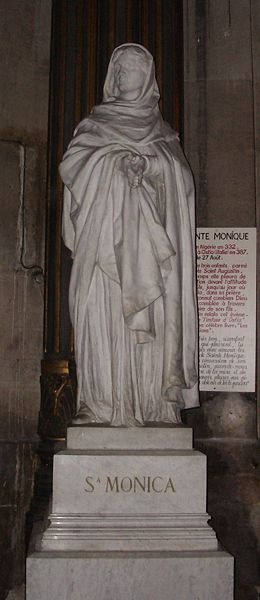
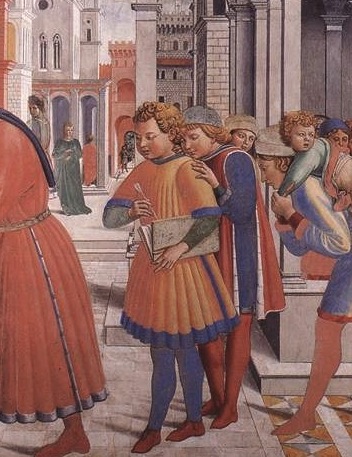
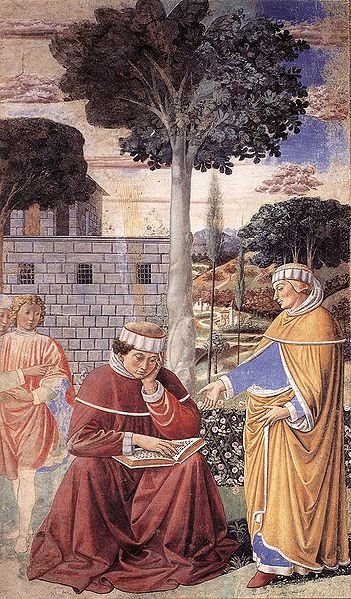

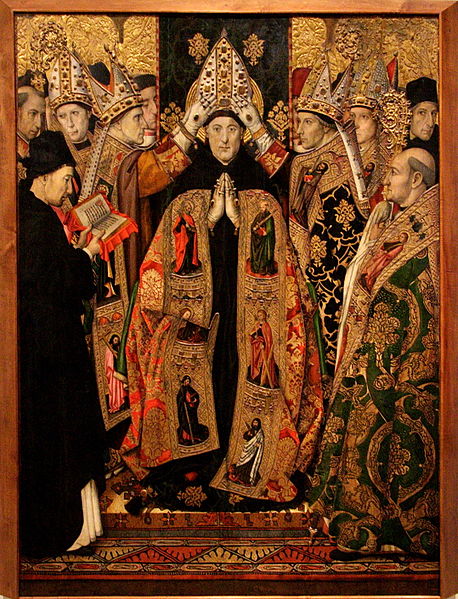
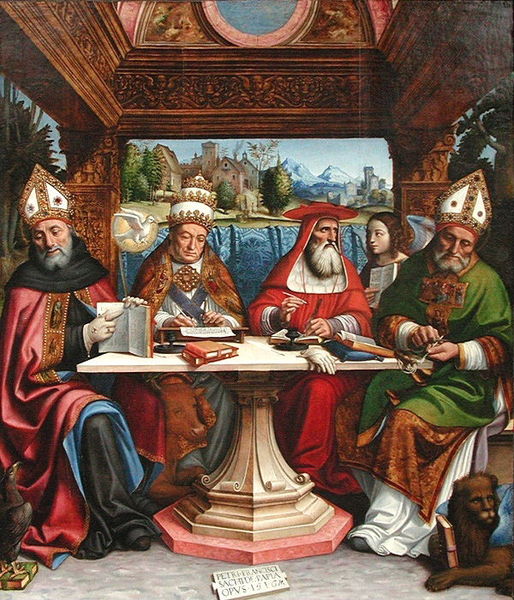
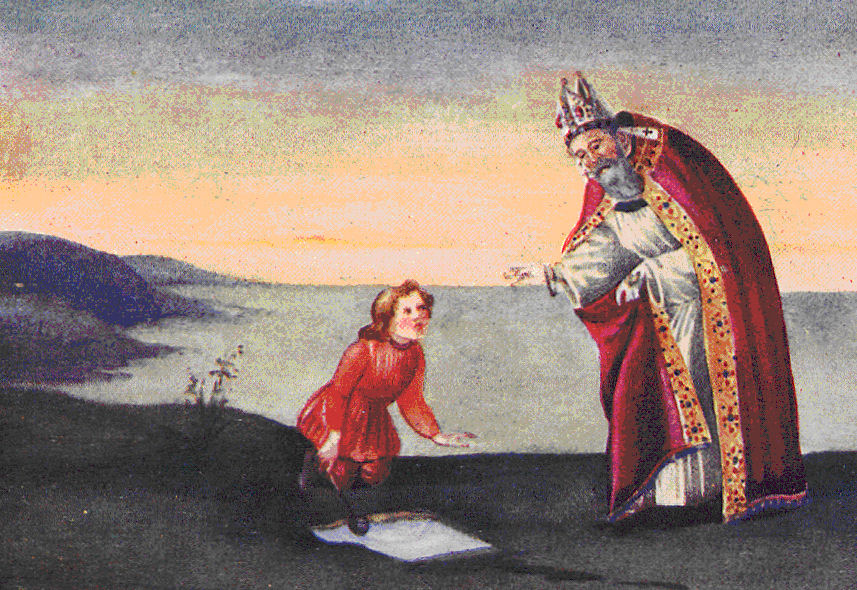
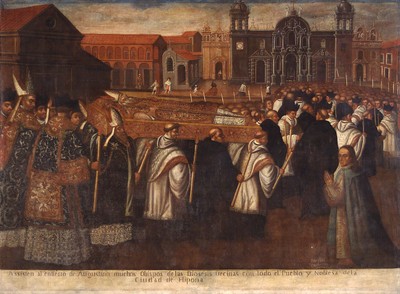
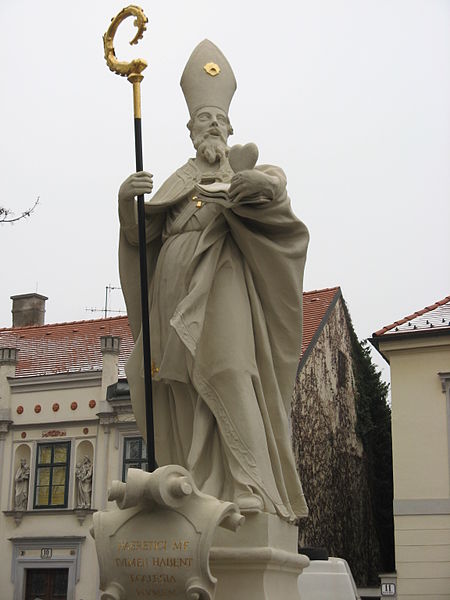
No comments:
Post a Comment